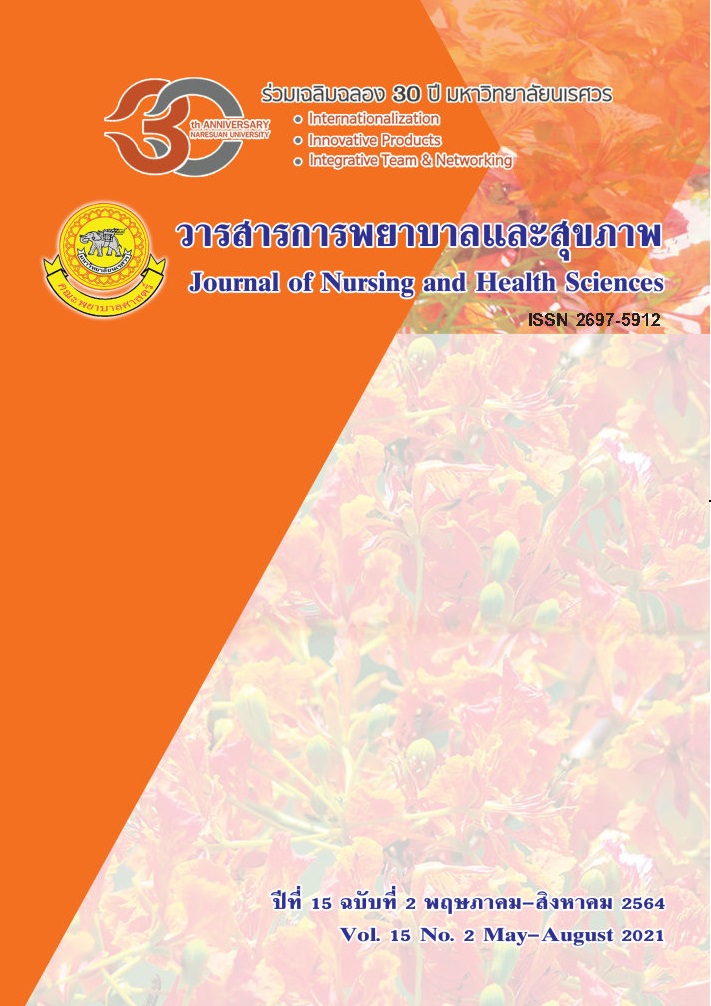ผลลัพธ์ทางด้านการทำหน้าที่ของร่างกาย และผลลัพธ์ทางด้านการทำหน้าที่ของร่างกายตามความคาดหวังของผู้ป่วยโรคหลอดเลือดสมองระยะเฉียบพลัน
Main Article Content
บทคัดย่อ
โรคหลอดเลือดสมองเป็นสาเหตุของการเสียชีวิตและเป็นสาเหตุหลักที่ทำให้เกิดความพิการทั่วโลก การวิจัยเชิงพรรณนาครั้งนี้ มีวัตถุประสงค์เพื่อ 1) ศึกษาผลลัพธ์ด้านการทำหน้าที่ของร่างกายในผู้ป่วยโรคหลอดเลือดสมองระยะเฉียบพลัน 2) ศึกษาผลลัพธ์ด้านการทำหน้าที่ของร่างกายตามความคาดหวังของผู้ป่วยโรคหลอดเลือดสมองระยะเฉียบพลัน ที่เข้ารับการรักษาที่โรงพยาบาลระดับตติยภูมิแห่งหนึ่ง ในกรุงเทพมหานคร จำนวน 155 ราย คัดเลือกกลุ่มตัวอย่างแบบเฉพาะเจาะจงตามเกณฑ์คัดเข้า เครื่องมือวิจัย ได้แก่ แบบสอบถามข้อมูลส่วนบุคคล ข้อมูลสุขภาพ National Institutes of Health Stroke Scale (NHISS), modified Rankin Scale (mRS), Barthel index (BI), EQ-5D-5L และแบบสอบถามผลลัพธ์ด้านการทำหน้าที่ของร่างกายตามความคาดหวังของผู้ป่วย วิเคราะห์ข้อมูลโดยใช้สถิติบรรยาย และสถิติอ้างอิง ผลการวิจัยพบว่า กลุ่มตัวอย่างส่วนใหญ่เป็นเพศชายร้อยละ 62.6 อายุเฉลี่ย 64 ปี (SD = 12.5) เป็นโรคหลอดเลือดสมองชนิดสมองขาดเลือดร้อยละ 89.6 ผลลัพธ์ด้านการทำหน้าที่ของร่างกายก่อนกลับบ้าน มีคะแนนเฉลี่ย NIHSS 4 คะแนน mRS 3 คะแนน BI 70.4 และค่าอรรถประโยชน์ 0.7 โดยผู้ป่วยชนิดเลือดออกในสมองมีผลลัพธ์ด้านการทำหน้าที่ของร่างกายแย่กว่าชนิดสมองขาดเลือดอย่างมีนัยสำคัญทางสถิติ (p<.05) มีการรายงานผลลัพธ์ด้านการทำหน้าที่ของร่างกายตามความคาดหวังดีขกว่าที่คาดหวังร้อยละ 37.5 เป็นไปตามที่คาดหวังร้อยละ 49 และแย่กว่าที่คาดหวังร้อยละ 13.5 ซึ่งผู้ป่วยที่มีผลลัพธ์ด้านการทำหน้าที่ของร่างกายตามความคาดหวังที่แตกต่างกันมีคะแนนผลลัพธ์ด้านการทำหน้าที่ของร่างกายแตกต่างกันอย่างมีนัยสำคัญทางสถิติ (p<.05)
Article Details

อนุญาตภายใต้เงื่อนไข Creative Commons Attribution-NonCommercial-NoDerivatives 4.0 International License.
เอกสารอ้างอิง
Bhalla, A., Wang, Y., Rudd, A., & Wolfe, C. D. (2013).
Differences in outcome and predictors between
ischemic and intracerebral hemorrhage: the South
London Stroke Register. Stroke, 44(8), 2174-2181.
doi:10.1161/strokeaha.113.001263
Bindawas, S. M., Vennu, V., Mawajdeh, H., & Alhaidary,
H. (2017). Functional outcomes by age after
inpatient stroke rehabilitation in Saudi Arabia.
Clin Interv Aging, 12, 1791-1797. doi:10.2147/
cia.S145402
Broderick, J. P., Adeoye, O., & Elm, J. (2017). Evolution
of the Modified Rankin Scale and Its Use in Future
Stroke Trials. Stroke, 48(7), 2007-2012. doi:
1161/strokeaha.117.017866
Buapang, S., & Putkanin, N. (2017). Quality of life of early
age patients with stroke at outpatient department,
Srinakarin hospital. North-Eastern Thai Journal
of Neuroscience, 11(4), 61-75.
Butsing, N. (2017). Quality-adjusted survival (QAS) among
patients with ischemic stroke and intracerebral
hemorrhage [Doctoral dissertation]: Mahidol
University.118
Butsing, N., Tipayamongkholgul, M., & Ratanakorn, D.
(2019). Estimation of expected years of life lost for
patients with ischemic stroke and intracerebral
hemorrhage. Journal of Health Research, 33(5),
-415. doi:10.1108/JHR-10-2018-0126
Butsing, N., Tipayamongkholgul, M., Ratanakorn, D.,
Suwannapong, N., & Bundhamcharoen, K. (2019).
Social support, functional outcome and quality of
life among stroke survivors in an urban area.Journal
of Pacific Rim Psychology, 13, e4. doi:10.1017/
prp.2019.2
Chaleoykitti, S., Srithumsuk, W., Jaipong, S., Pattayakorn,
P., Pattayakorn, P., & Podimuang, K. (2020).
Association between Clinical Characteristics and
Quality of Life in Older People with Stroke at
Hospital Discharge. Advances in Aging Research,
(4), 67-76. doi:10.4236/aar.2020.94006
Chiu, D., Peterson, L., Elkind, M. S. V., Rosand, J.,
Gerber, L. M., & Silverstein, M. D. (2010).
Comparison of outcomes after intracerebral
hemorrhage and ischemic stroke. Journal of Stroke
& Cerebrovascular Diseases, 19(3), 225-229.
doi:10.1016/j.jstrokecerebrovasdis.2009.06.002
Chou, C. Y. (2015). Determinants of the health-related
quality of life for stroke survivors. Journal of Stroke
& Cerebrovascular Diseases, 24(3), 655-662.
doi:10.1016/j.jstrokecerebrovasdis.2014.10.022
Davis, S., Lees, K., & Donnan, G. (2006). Treating the
acute stroke patient as an emergency: current
practices and future opportunities. International
journal of clinical practice, 60(4), 399-407.
doi:10.1111/j.1368-5031.2006.00873.x
Faul, F., Erdfelder, E., Lang, A.-G., & Buchner, A. (2007).
G*Power 3: A flexible statistical power analysis
program for the social, behavioral, and biomedical
sciences. Behavior Research Methods, 39(2),
-191. doi:10.3758/BF03193146
Feigin, V. L., Norrving, B., & Mensah, G. A. (2017).
Global Burden of Stroke.Circulation Research,
(3), 439-448. doi:10.1161/CIRCRESAHA.
308413
Hemphill, J. C., Greenberg, S. M., Anderson, C. S., Becker,
K., Bendok, B. R., Cushman, M., . . . Woo, D.
(2015). Guidelines for the Management of
Spontaneous Intracerebral Hemorrhage.Stroke,
(7), 2032-2060. doi:10.1161/STR.000000000000
Hinkle, J. L. (2014). Reliability and Validity of the National
Institutes of Health Stroke Scale for Neuroscience
Nurses. Stroke, 45(3), e32-e34. doi:10.1161/
STROKEAHA.113.004243
International Health Policy Program Foundation. (2017).
Burden of Disease Thailand 2014. Retrieved
from Nonthaburi: The Graphigo Systems.
Katan, M., & Luft, A. (2018). Global Burden of Stroke.
Seminars Neurology, 38(2), 208-211. doi:10.1055/
s-0038-1649503
Kleindorfer, D. O., Towfighi, A., Chaturvedi, S., Cockroft,
K. M., Gutierrez, J., Lombardi-Hill, D., . . .
Williams, L. S. (2021). 2021 Guideline for the
Prevention of Stroke in Patients With Stroke and
Transient Ischemic Attack: A Guideline From the
American Heart Association/American Stroke
Association.Stroke, 52(7), e364-e467. doi:10.1161/
STR.0000000000000375
Mahoney, F. I., & Barthel, D. W. (1965). FUNCTIONAL
EVALUATION: THE BARTHEL INDEX.
Maryland State Medical Journal, 14, 61-65.
Ortiz, G. A., & L. Sacco, R. (2014). National Institutes
of Health Stroke Scale (NIHSS). In Wiley Stats
Ref: Statistics Reference Online.
Panthong, P., & Phatisena, T. (2018). The empowerment
of caregivers for rehabilitation of stroke patients
at Maharat Nakhon Ratchasima Hospital. Journal
of the Office of DPC 9, 24(2), 57- 66.
Pattanaphesaj, J. (2014). Health-related quality of life
measure (EQ-5D-5L): measurement property
testing and its preferencebased score in Thai
population [Doctoral dissertation]: Mahidol
University.
Powers, W. J., Rabinstein, A. A., Ackerson, T., Adeoye,
O. M., Bambakidis, N. C., Becker, K., . . .
Tirschwell, D. L. (2019). Guidelines for the Early
Management of Patients With Acute Ischemic
Stroke: 2019 Update to the 2018 Guidelines for
the Early Management of Acute Ischemic Stroke:
A Guideline for Healthcare Professionals From
the American Heart Association/American Stroke
Association.Stroke, 50(12), e344-e418. doi:10.
/STR.0000000000000211
Quinn, T. J., Dawson, J., Walters, M. R., & Lees, K. R.
(2009). Reliability of the Modified Rankin
Scale.Stroke, 40(10), 3393-3395. doi:10.1161/
STROKEAHA.109.557256
Rachpukdee, S., Howteerakul, N., Suwannapong, N., &
Tang-Aroonsin, S. (2013). Quality of life of
stroke survivors: a 3-month follow-up study.
Journal of Stroke & Cerebrovascular Diseases,
(7), e70-78. doi:10.1016/j.jstrokecerebrovasdis.
05.005
Rankin, J. (1957). Cerebral vascular accidents in patients
over the age of 60. II. Prognosis. Scottish Medical
Journal, 2(5), 200-215. doi:10.1177/003693305700
Sturm, J. W., Donnan, G. A., Dewey, H. M., Macdonell,
R. A., Gilligan, A. K., Srikanth, V., & Thrift, A. G.
(2004). Quality of life after stroke: the North East
Melbourne Stroke Incidence Study (NEMESIS).
Stroke, 35(10), 2340-2345. doi:10.1161/
STR.0000141977.18520.3b
Suksathien R, & Sukpongthai T. (2017). Predictors of
long-term functional outcomes in acute stroke
patients. Journal of Thai Rehabilitation Medicine,
(3), 96-100. doi:10.14456/jtrm.2017.20
Tadi, P., & Lui, F. (2021). Acute Stroke. [Updated 2021
Mar 24]. In: StatPearls [Internet]. Treasure Island
(FL): StatPearls Publishing. Retrieved from https:/
/www.ncbi.nlm.nih.gov/books/NBK535369/
Wouters, A., Nysten, C., Thijs, V., & Lemmens, R. (2018).
Prediction of Outcome in Patients With Acute
Ischemic Stroke Based on Initial Severity and
Improvement in the First 24 h. Frontiers in
Neurology, 9(308). doi:10.3389/fneur.2018.00308


